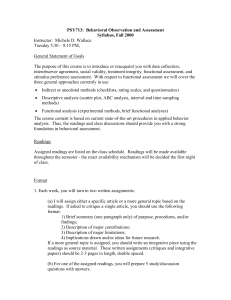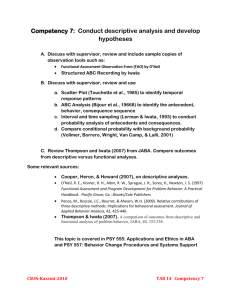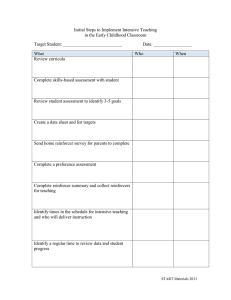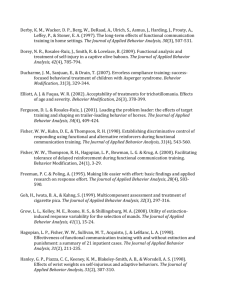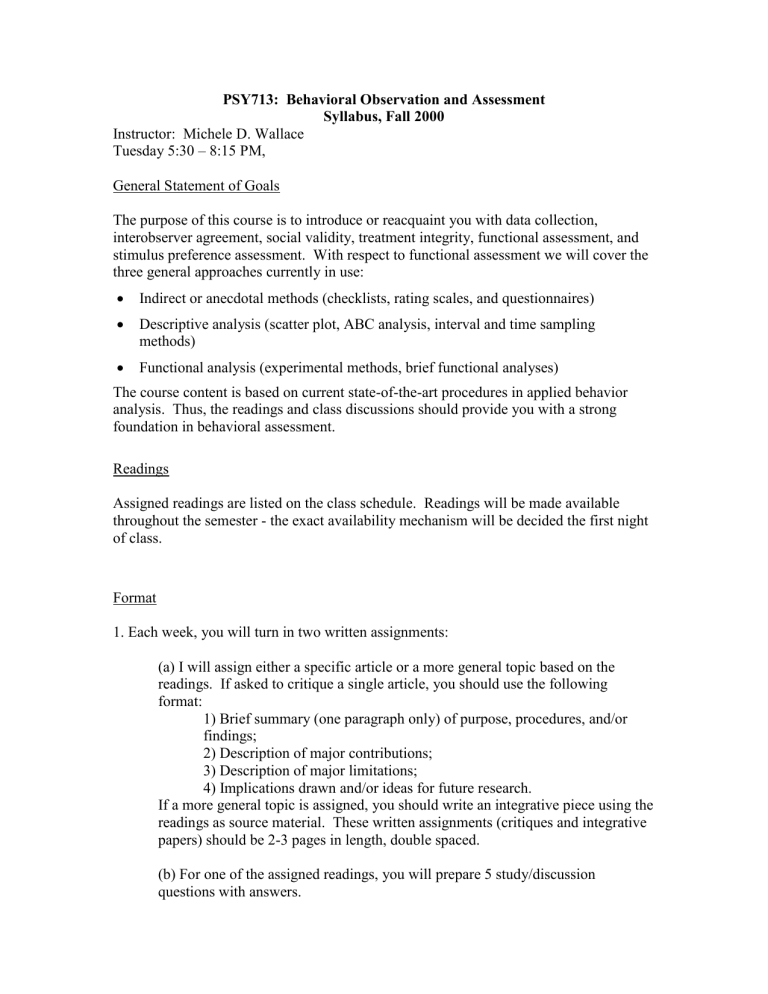
PSY713: Behavioral Observation and Assessment Syllabus, Fall 2000 Instructor: Michele D. Wallace Tuesday 5:30 – 8:15 PM, General Statement of Goals The purpose of this course is to introduce or reacquaint you with data collection, interobserver agreement, social validity, treatment integrity, functional assessment, and stimulus preference assessment. With respect to functional assessment we will cover the three general approaches currently in use: Indirect or anecdotal methods (checklists, rating scales, and questionnaires) Descriptive analysis (scatter plot, ABC analysis, interval and time sampling methods) Functional analysis (experimental methods, brief functional analyses) The course content is based on current state-of-the-art procedures in applied behavior analysis. Thus, the readings and class discussions should provide you with a strong foundation in behavioral assessment. Readings Assigned readings are listed on the class schedule. Readings will be made available throughout the semester - the exact availability mechanism will be decided the first night of class. Format 1. Each week, you will turn in two written assignments: (a) I will assign either a specific article or a more general topic based on the readings. If asked to critique a single article, you should use the following format: 1) Brief summary (one paragraph only) of purpose, procedures, and/or findings; 2) Description of major contributions; 3) Description of major limitations; 4) Implications drawn and/or ideas for future research. If a more general topic is assigned, you should write an integrative piece using the readings as source material. These written assignments (critiques and integrative papers) should be 2-3 pages in length, double spaced. (b) For one of the assigned readings, you will prepare 5 study/discussion questions with answers. 2. Class time will be devoted to lecture/discussion. Lectures, when given, will provide an overview of the topic or supplementary information and usually will be brief. You will be required to be an active participant in class discussions. Both small group and large group discussion formats with be used. Research Proposal Each student will be responsible for reviewing the research literature and proposing a research study. The written research proposal must follow the format recommended by the American Psychological Association (see Publication Manual of the American Psychological Association, 4th edition). The proposal should include a brief introduction (i.e., a literature review and justification for the experiment), method, expected results, discussion (i.e., implication), and reference section. The text of the proposal should not exceed 10 double-spaced pages. On the last day of class, every student will provide a brief (5-10 min) presentation of their research proposal. Grading For the purpose of feedback, I will grade your weekly papers on a 10-pt basis (8 points for content, 2 points for style). Study questions will be graded as acceptable/unacceptable. If you receive an unacceptable grade, you will be asked to rewrite one or more questions. Course grades will be a composite reflecting your performance on weekly papers (40%), the research proposal (30%) class discussions (20%) and study questions (10%). Grades will be assigned as follows: 100-90% = A, 89-80% = B, 79-70% = C, etc. Course Schedule 8/29 Introduction and Syllabus 9/5 Observation and Data Collection 9/12 Interobserver Agreement 9/19 Indirect (Anecdotal) Assessment I 9/26 Indirect (Anecdotal) Assessment II 10/3 Descriptive Analysis I 10/10 Descriptive Analysis II 10/17 Experimental Analysis I – Early Examples 10/24 Experimental Analysis II – Basic Paradigms 10/31 Experimental Analysis III – Methodological Changes 11/7 Experimental Analysis IV – Procedural Changes 11/14 Reinforcer Assessment I 11/21 Reinforcer Assessment II 11/28 Social Validity 12/5 Treatment Integrity 12/12 Research Proposals Students with Disabilities Statement The Psychology Department is committed to equal opportunity in education for all students, including those with documented physical disabilities or documented learning disabilities. University policy states that it is the responsibility of students with documented disabilities to contact instructors during the first week of each semester to discuss appropriate accommodations to ensure equity in grading, classroom experience, and outside assignments. The instructor will meet with the student and staff members of the Student Services Center to formulate a written plan for appropriate accommodations, if required. PSY713: Behavioral Observation and Assessment Fall, 2000 Class Schedule and Readings Date Assignment 8/29: Introduction and Syllabus 9/5: Observation and Data Collection Kazdin, A. E. (1982). Single-case research designs: Methods for clinical and applied settings (Ch. 2). Oxford: Oxford University. (Behavioral Assessment) Poling, A., Methot, L. L., & LeSage, M. G. (1995). Fundamentals of behavior analytic research (Ch. 4). New York: Plenum. (Data Collection, pp. 55-72) Cooper, J. O., Heron, T. E., B Heward, W. L. (1987). Applied behavior analysis (Ch. 3). Columbus, OH: Men’ll. (Selecting and Defining Target Behavior) Cooper, J. O., Heron, T. E., & Heward, W. L. (1987). Applied behavior analysis (Ch. 4). Columbus,OH: Merill. (Measuring and Recording Behavior) Cooper, J. O., Heron, T. E., & Heward, \N. L. (1987). Applied behavior analysis (Ch. 5). Columbus, OH: Merill. (Planning and Directing Observational Procedures, pp. 81-91) 9/12: Interobserver Agreement Repp, A. C., Deitz, D. E. D., Boles, S. M., Deitz, S. M., & Repp, C. F. (1976). Differences among methods for calculating interobserver agreement. Journal of Applied Behavior Analysis, 9, 109-113. Hopkins, B. L., & Hermann, J. A. (1977). Evaluating interobserver reliability of interval data. Journal of Applied Behavior Analysis, 10, 121-126. Kazdin, A. E. (1977). Artifact, bias, and complexity of assessment: The ABCs of reliability. Journal of Applied Behavior Analysis, 10, 141-150. Harris, F. C., & Lahey, B. B. (1978). A method for combining occurrence and nonoccurrence interobserver agreement scores. Journal of Applied Behavior Analysis, 11, 523-527. Birkimer, J. C., & Brown, J. H. (1979). A graphical judgmental aid which summarizes obtained and chance reliability data and helps assess the believability of experimental effects. Journal of Applied Behavior Analysis, 12, 523-533. Carr, J. E., Austin, J., Hatfield, D. B., & Bailey, J. S. (1996). The standard deviation as an informative measure of variability in reporting interobserver agreement means. Journal of Behavior Therapy and Experimental Psychiatry, 27, 263-267. 9/19 Indirect (Anecdotal) Assessment I: Wiesler, N. A., Hanson, R. H., Chamberlain, T. P., & Thompson, T. (1985). Functional taxonomy of stereotypic and self-injurious behavior. Mental Retardation, 23, 230-234. Durand, V. M., & Crimmins, D. B. (1988). Identifying the variables maintaining selfinjurious behavior. Journal of Autism and Developmental Disorders, 18, 99-117. Zarcone, J. R., Rodgers, T. A., Iwata, B. A., Rourke, D., & Dorsey, M. F. (1991). Reliability analysis of the Motivation Assessment Scale: A failure to replicate. Research in Developmental Disabilities, 12, 349-360. Sigafoos, J., Kerr, M., Roberts, D., & Couzens, D. (1993). Reliability of structured interviews for the assessment of challenging behaviour. Behaviour Change, 10, 47-50. 9/26 Indirect (Anecdotal) Assessment II: Sturmey, P. (1994). Assessing the functions of aberrant behaviors: A review of psychometric instruments. Journal of Autism and Developmental Disorders, 24, 293304. DeLeon, I. G., & Iwata, B. A. Reliability analysis of indirect assessment methods. Iwata, B. A., & DeLeon, I. G. Reliability and validity analysis of the Functional Analysis Screening Tool (FAST). 10/3 Descriptive Analysis I: Touchette, P. E., MacDonald, R. F., & Langer, S. N. (1985). A scatter plot for identifying stimulus control of problem behavior. Journal of Applied Behavior Analysis, 18, 343-351. Kahng. S., Iwata, B. A., Fischer, S. M., Page, T. J., Treadwell, K. R. H., Williams, D. E., & Smith, R. G. (1998). Temporal distributions of problem behavior based on scatter plot analysis. Journal of Applied Behavior Analysis, 31, 593-604. Groden, G. (1989). A guide for conducting a comprehensive behavioral analysis of a target behavior. Journal of Behavior Therapy and Experimental Psychiatry, 20, 163-169. 10/10 Descriptive Analysis II: Mace, F. C., & Lalli, J. S. (1991). Linking descriptive and experimental analyses in the treatment of bizarre speech. Journal of Applied Behavior Analysis, 24, 553-562. Sasso, G. M., Reimers, T. M., Cooper, L. J., Wacker, D., Berg, W., Steege, M., Kelly, L., & Allaire, A. (1992). Use of descriptive and experimental analyses to identify the functional properties of aberrant behavior in school settings. Journal of Applied Behavior Analysis, 25, 809-822. Lerman, D. C., & Iwata, B. A. (1993). Descriptive and experimental analyses of variables maintaining self-injurious behavior. Journal of Applied Behavior Analysis, 26, 293-319. Emerson, E., Thompson, S., Reeves, D., Henderson, D., & Robertson, J. (1995). Descriptive analysis of multiple response topographies of challenging behaviors across two settings. Research in Developmental Disabilities, 16, 301-329. Conroy, M., Fox, J., Crain, L., Jenkins, A., & Belcher, K. (1996). Evaluating the social and ecological validity of analog assessment procedures for challenging behaviors in young children. Education and Treatment of Children, 19, 233-256. 10/17 Experimental Analysis – Early Examples: Lovaas, O. I., & Simmons, J. Q. (1969). Manipulation of self-destructive in three retarded children. Journal of Applied Behavior Analysis, 2, 143-157. Schaefer, H. H. (1970). Self-injurious behavior: Shaping “head-banging” in monkeys. Journal of Applied Behavior Analysis, 3, 111-116. Adams, G. L., Tallon, R. J., & Stangle, J. M. (1980). Environmental influences on self-stimulatory behavior. American Journal of Mental Deficiency, 85, 171-175. Carr, E. G., Newsom, C. D., & Binkoff, J. A. (1980). Escape as a factor in the aggressive behavior of two retarded children. Journal of Applied Behavior Analysis, 13, 101-117. 10/24 Experimental Analysis – Basic Paradigms: Iwata, B. A., Dorsey, M. F., Slifer, K. J., Bauman, K. E., & Richman, G. S. (1994). Toward a functional analysis of self-injury. Journal of Applied Behavior Analysis, 27, 197-209. Reprinted from Analysis and Intervention in Developmental Disabilities, 2, 320. Iwata, B. A., Pace, G. M., Dorsey, M. F., Zarcone, J. R., Vollmer, T. R., Smith, R. G., Rodgers, T., A., Lerman, D. C., Shore, B. A., Mazaleski, J. L., Goh, H., Cowdery, G. E., Kalsher, M. J., & Willis, K. D. (1994). The functions of self-injurious behavior: An experimental-epidemiological analysis. Journal of Applied Behavior Analysis, 27, 111126. Carr, E. G., & Durand, V. M. (1985). Reducing behavior problems through functional communication training. Journal of Applied Behavior Analysis, 18, 111-126. Mace, F. C., Page, T. J., Ivancic, M. T., & O’Brien, S. (1986). Analysis of environmental determinants of aggression and disruption in mentally retarded children. Applied Research in Mental Retardation, 7, 203-221. 10/31 Experimental Analysis – Methodological Changes: Northup, J., Wacker, D., Sasso, G., Steege, M., Cigrand, K., Cook, J., & DeRaad, A. (1991). A brief functional analysis of aggressive and alternative behavior in an outclinic setting. Journal of Applied Behavior Analysis, 24, 509-522. Vollmer, T. R., Iwata, B. A., Duncan, B. A., & Lerman, D. C. (1993). Within-session patterns of self-injury as indicators of behavioral function. Research in Developmental Disabilities, 14, 479-492. Iwata, B. A., Duncan, B. A., Zarcone, J. R., Lerman, D. C., & Shore, B. A. (1994). A sequential, test-control methodology for conducting functional analyses of self-injurious behavior. Behavior Modification, 18, 289-306. Vollmer, T. R., Marcus, B. A., Ringdahl, J. E., & Roan, H. S. (1995). Progressing from brief assessments to extended experimental analyses in the evaluation of aberrant behavior. Journal of Applied Behavior Analysis, 28, 561-576. 11/7 Experimental Analysis – Procedural Changes: Fisher, W. W., Ninness, H. A. C., & Piazza, C. C. (1996). On the reinforcing effects of the content of verbal attention. Journal of Applied Behavior Analysis, 29, 235-238. Fisher, W. W., Piazza, C. C., & Chiang, C. L. (1996). Effects of equal and unequal reinforcer duration during functional analysis. Journal of Applied Behavior Analysis, 29, 117-120. Northup, J. Broussard, C., Jones, K., George, T., Vollmer, T. R., & Herring, M. (1995). The differential effects of teacher and peer attention on the disruptive classroom behavior of three children with a diagnosis of attention deficit hyperactivity disorder. Journal of Applied Behavior Analysis, 28, 227-228. O’Reilly, M. F. (1995). Functional analysis and treatment of escape-maintained aggression correlated with sleep deprivation. Journal of Applied Behavior Analysis, 28, 225-226. Kennedy, C. H., & Meyer, K. A. (1996). Sleep deprivation, allergy symptoms, and negatively reinforced problem behaviors. Journal of Applied Behavior Analysis, 29, 133135. 11/14 Reinforcement Assessment I: Pace, G. M., Ivancic, M. T., Edwards, G. L., Iwata, B. A., & Page, T. J. (1985). Assessment of stimulus preference and reinforcer value with profoundly retarded individuals. Journal of Applied Behavior Analysis, 18, 249-255. Fisher, W., Piazza, C. C., Bowman, L. G., Hagopian, L. P., Owens, J. C., & Slevin, I. (1992). A comparison of two approaches for identifying reinforcers for persons with severe and profound disabilities. Journal of Applied Behavior Analysis, 25, 491-498. DeLeon, I. G., & Iwata, B. A. (1996). Evaluation of a multiple-stimulus presentation format for assessing reinforcer preferences. Journal of Applied Behavior Analysis, 29, 519-533. Fisher, W. W., Piazza, C. C., Bowman, L. G., & Amari, A. (1996). Integrating caregiver report with a systematic choice assessment to enhance reinforcer identification. American Journal on Mental Retardation, 101, 15-25. Green, C. W., Reid, D. H., White, L. K., Halford, R. C., Brittain, D. P., & Gardner, S. M. (1988). Identifying reinforcers for persons with profound handicaps: Staff opinion versus systematic assessment of preferences. Journal of Applied Behavior Analysis, 21, 31-43. 11/21 Reinforcement Assessment II: Roane, H. S., Vollmer, T. R., Ringdahl, J. E., Marcus, B. A. (1998). Evaluation of a brief stimulus preference assessment. Journal of Applied Behavior Analysis, 31, 605620. Egel, A. L. (1981). Reinforcer variation: Implications for motivating developmentally disabled children. Journal of Applied Behavior Analysis, 14, 345-350. Bowman, L. G., Piazza, C. C., Fisher, W. W., Hagopian, L. P., & Kogan, J. S. (1997). Assessment of preference for varied versus constant reinforcers. Journal of Applied Behavior Analysis, 30, 451-458. DeLeon, I. G., Iwata, B. A., & Goh, H., Worsdell, A. S. (1997). Emergence of reinforcer preference as a function of schedule requirements and stimulus similarity. Journal of Applied Behavior Analysis, 30, 439-449. Roscoe, E. M., Iwata, B. A., & Kahng, S. (1999). Relative versus absolute reinforcement effects: Implications for preference assessments. Journal of Applied Behavior Analysis, 32, 479-493. 11/28 Social Validity: Wolf, M. M. (1978). Social validity: The case for subjective measurement or how applied behavior analysis is finding its heart. Journal of Applied Behavior Analysis, 11, 203-214. Van Houten, R. (1979). Social validation: The evolution of standards of competency for target behaviors. Journal of Applied Behavior Analysis, 12, 581-591. Schwartz, I. S., & Baer, D. M. (1991). Social validity assessments: Is current practice state of the art? Journal of Applied Behavior Analysis, 24, 189-204. Kennedy, C. H. (1992). Trends in the measurement of social validity. The Behavior Analyst, 15, 147-156. 12/5 Treatment Integrity: Peterson, L., Homer, A. L., & Wonderlich, S. A. (1982). The integrity of independent variables in behavior analysis. Journal of Applied Behavior Analysis, 15, 477-492. Alkhateeb, J. M. Y. (1988). Independent variable integrity in behavioral research: A review of the literature. Scandinavian Journal of Behavior Therapy, 17, 189-199. Salend, S. J. (1984). Therapy outcome research: Threats to treatment integrity. Behavior Modification, 8, 211-222. Gresham, F. M. (1989). Assessment of treatment integrity in school consultation and prereferral intervention, School Psychology Review, 18, 37-50. 12/12 Research Proposals
